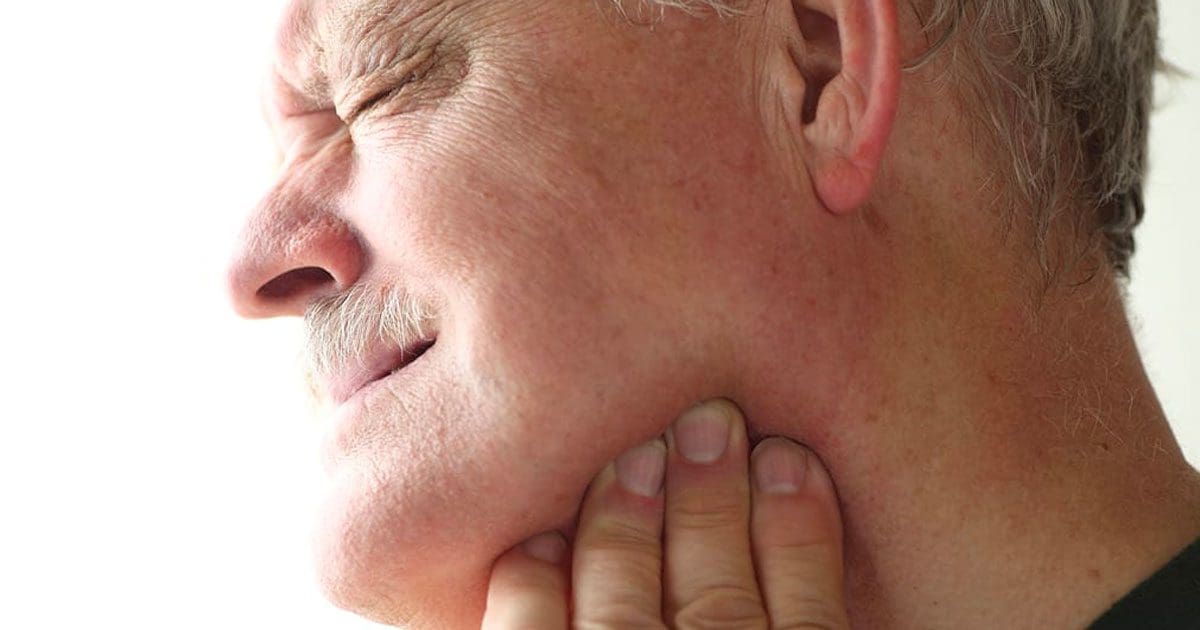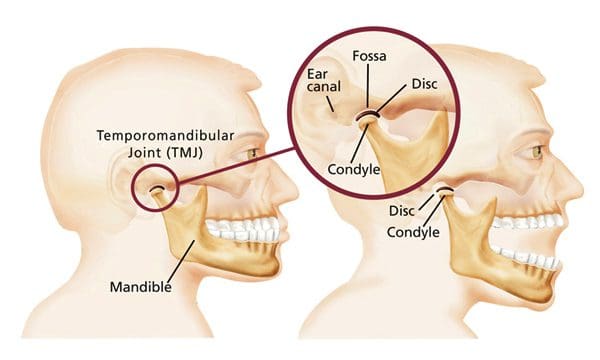Table of Contents
Introduction
The lower jaw of the body has the mastication muscles surrounding the mandible and provides functionality to the jaw through chewing, moving the lower jaw up, down, left, and right, and speaking. The jaw also has joints known as the temporomandibular joints that slide back and forth to provide movement also. The jaw is also home to the teeth and tongue, which play a role in the mouth by consuming and grinding food into smaller bites to travel down to the gut system. Just like every joint and muscle in the body, common issues or injuries can affect the jaw and cause pain symptoms associated with the problem. Sometimes normal wear and tear can affect the joints in the jaw, or traumatic events can affect the surrounding muscles causing soreness in the jaw area. If the issue involving the jaw is not treated over time, it can lead to chronic disorders and overlap with other chronic disorders that can affect the whole body and the jaw. One of the jaw disorders is TMJ dysfunction, which can cause overlapping symptoms in the jaw and the body. Today’s article examines what TMJ dysfunction is, the signs and symptoms, and ways to manage TMJ dysfunction in the jaw. We refer patients to certified providers who specialize in musculoskeletal and oral treatments to aid individuals suffering from TMJ dysfunction affecting their jaws. We also guide our patients by referring them to our associated medical providers based on their examination when appropriate. We ensure to find that education is the solution to asking our providers insightful questions. Dr. Jimenez DC observes this information as an educational service only. Disclaimer
What Is TMJ Dysfunction?
Have you been experiencing muscle pain in your neck, shoulders, and jaw? What about tenderness in your cheek when you lightly touched it? Or do you have difficulty chewing or moving your jaw when speaking? Many of these symptoms are signs that you could be experiencing TMJ dysfunction in your jaw. TMJ dysfunction, or temporomandibular dysfunction, is part of a group of orofacial pain conditions that affects the jaw joint and muscle, thus causing overlapping issues in the lower jaw. TMJ dysfunction also affects the mastication muscles that help move the jaw by making the muscles hyperactive and causing referred pain to the rest of the body. Studies reveal that about 25% of the population does get affected by TMJ dysfunction since it is a degenerative musculoskeletal condition associated with morphological and functional jaw deformities.
The Signs & Symptoms Of TMJ Dysfunction On The Jaw
TMJ dysfunction may potentially not only cause jaw pain but can also affect the neck and shoulders connected to the cervical spine. Studies reveal that TMJ dysfunction is correlated with neck disability, jaw dysfunction, and muscle tenderness in many individuals that suffer pain with or without TMJ dysfunction. TMJ dysfunction is associated with these issues because the jaw structures are affected by trigger points along the neck and jaw. To that point, TMJ dysfunction is often accompanied by back, joint, and abdominal pain. But how would TMJ dysfunction correlate with these pain issues? Studies reveal that disturbances in the upper body extremities may cause an increase in muscle tension associated with the whole-body imbalance that is potentially causing TMJ dysfunction. Some of the related symptoms of TMJ dysfunction in the jaw include:
- Pain in neck and shoulders
- The jaw becomes “locked” in an open or closed position
- Headaches
- Earaches
- Muscle tenderness in the jaw
- Having difficulty chewing
- Swelling on the side of the face
- Body imbalance
Exercises For TMJ Dysfunction- Video
Have you been experiencing muscle tenderness in your jaw? What about having some difficulty chewing or speaking? Do you hear popping sounds when your open or close your mouth? Some of these symptoms are associated with a musculoskeletal jaw disorder known as TMJ (temporomandibular joint) dysfunction. The video above shows the top 3 exercises for TMJ dysfunction that can help alleviate pain from the jaw, face, or ear. TMJ dysfunction is a musculoskeletal disorder that affects the mastication muscles and causes referred pain to the neck, head, and ear. TMJ dysfunction is tricky to diagnose since trigger points associated with TMJ may also affect the teeth, causing tooth pain in the oral-facial region. This is known as somato-visceral, where the affected muscle correlates with the corresponding organ. Thankfully, there are ways to manage TMJ dysfunction and its associated symptoms.
Ways To Manage TMJ Dysfunction In The Jaw
Many people can use various ways to manage TMJ dysfunction in the jaw to alleviate the pain. Some non-surgical treatments that individuals can incorporate include:
- Heat or cold pack applied to the side of the face
- Gentle stretching exercises for the jaw
- Eating soft foods
- Wearing a night guard while sleeping
If the pain from TMJ dysfunction still affects the individual, therapies like chiropractic care can help manage the symptoms. Chiropractic care can effectively treat TMJ dysfunction, especially spinal subluxation or misalignment in the cervical region. Chiropractors will fully evaluate the patient’s temporomandibular joint and surrounding muscles, joints, and ligaments to identify the TMJ problem and the underlying causes. To that point, a chiropractor may suggest a range of treatments, which includes stretches and exercises to not only alleviate pain and stiffness in the jaw point but also to bring back balance to the body. This allows minimal rubbing and friction in the jaw joint.
Conclusion
Overall, TMJ dysfunction is a musculoskeletal jaw disorder that affects the mastication muscles and causes referred pain to different areas in the upper extremities of the body. Some of the symptoms of TMJ dysfunction can make it difficult for the jaw to open or close, causing pain, headaches, and muscle tenderness in the neck and shoulders. To that point, individuals suffering from TMJ dysfunction may potentially deal with pain-related symptoms. Various non-surgical treatments are available to manage TMJ dysfunction and reduce associated pain symptoms affecting the jaw.
References
Kim, Doori, et al. “The Relationship between Spinal Pain and Temporomandibular Joint Disorders in Korea: A Nationwide Propensity Score-Matched Study – BMC Musculoskeletal Disorders.” BioMed Central, BioMed Central, 29 Dec. 2019, bmcmusculoskeletdisord.biomedcentral.com/articles/10.1186/s12891-019-3003-4.
Murphy, Meghan K, et al. “Temporomandibular Disorders: A Review of Etiology, Clinical Management, and Tissue Engineering Strategies.” The International Journal of Oral & Maxillofacial Implants, U.S. National Library of Medicine, 2013, www.ncbi.nlm.nih.gov/pmc/articles/PMC4349514/.
Silveira, A, et al. “Jaw Dysfunction Is Associated with Neck Disability and Muscle Tenderness in Subjects with and without Chronic Temporomandibular Disorders.” BioMed Research International, Hindawi Publishing Corporation, 2015, www.ncbi.nlm.nih.gov/pmc/articles/PMC4391655/.
Walczyńska-Dragon, Karolina, et al. “Correlation between TMD and Cervical Spine Pain and Mobility: Is the Whole Body Balance TMJ Related?” BioMed Research International, Hindawi Publishing Corporation, 2014, www.ncbi.nlm.nih.gov/pmc/articles/PMC4090505/.
Disclaimer
Post Disclaimer
Professional Scope of Practice *
The information herein on "What Is TMJ Dysfunction?" is not intended to replace a one-on-one relationship with a qualified health care professional or licensed physician and is not medical advice. We encourage you to make healthcare decisions based on your research and partnership with a qualified healthcare professional.
Blog Information & Scope Discussions
Welcome to El Paso's Wellness blog, where Dr. Alex Jimenez, DC, FNP-C, a board-certified Family Practice Nurse Practitioner (FNP-C) and Chiropractor (DC), presents insights on how our team is dedicated to holistic healing and personalized care. Our practice aligns with evidence-based treatment protocols inspired by integrative medicine principles, similar to those found on dralexjimenez.com, focusing on restoring health naturally for patients of all ages.
Our areas of chiropractic practice include Wellness & Nutrition, Chronic Pain, Personal Injury, Auto Accident Care, Work Injuries, Back Injury, Low Back Pain, Neck Pain, Migraine Headaches, Sports Injuries, Severe Sciatica, Scoliosis, Complex Herniated Discs, Fibromyalgia, Chronic Pain, Complex Injuries, Stress Management, Functional Medicine Treatments, and in-scope care protocols.
Our information scope is limited to chiropractic, musculoskeletal, physical medicine, wellness, contributing etiological viscerosomatic disturbances within clinical presentations, associated somato-visceral reflex clinical dynamics, subluxation complexes, sensitive health issues, and functional medicine articles, topics, and discussions.
We provide and present clinical collaboration with specialists from various disciplines. Each specialist is governed by their professional scope of practice and their jurisdiction of licensure. We use functional health & wellness protocols to treat and support care for the injuries or disorders of the musculoskeletal system.
Our videos, posts, topics, subjects, and insights cover clinical matters, issues, and topics that relate to and directly or indirectly support our clinical scope of practice.*
Our office has reasonably attempted to provide supportive citations and has identified the relevant research studies or studies supporting our posts. We provide copies of supporting research studies available to regulatory boards and the public upon request.
We understand that we cover matters that require an additional explanation of how they may assist in a particular care plan or treatment protocol; therefore, to discuss the subject matter above further, please feel free to ask Dr. Alex Jimenez, DC, APRN, FNP-BC, or contact us at 915-850-0900.
We are here to help you and your family.
Blessings
Dr. Alex Jimenez DC, MSACP, APRN, FNP-BC*, CCST, IFMCP, CFMP, ATN
email: coach@elpasofunctionalmedicine.com
Licensed as a Doctor of Chiropractic (DC) in Texas & New Mexico*
Texas DC License # TX5807
New Mexico DC License # NM-DC2182
Licensed as a Registered Nurse (RN*) in Texas & Multistate
Texas RN License # 1191402
ANCC FNP-BC: Board Certified Nurse Practitioner*
Compact Status: Multi-State License: Authorized to Practice in 40 States*
Graduate with Honors: ICHS: MSN-FNP (Family Nurse Practitioner Program)
Degree Granted. Master's in Family Practice MSN Diploma (Cum Laude)
Dr. Alex Jimenez, DC, APRN, FNP-BC*, CFMP, IFMCP, ATN, CCST
My Digital Business Card




